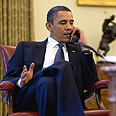
Poll the people
US should induce leaders to take moderate positions via Israeli, PA peace referendums
Whether or not Israeli-Palestinian proximity talks will begin on time, the Israeli-American proximity talks seem well under way. President Barack Obama’s second (and still counting) surprise meeting with Israeli Minister of Defense Ehud Barak, and his even more surprising phone call with Israeli PM Benjamin Netanyahu, signal that the two rivals are finally willing to bridge their differences.
Indeed, with the US and Israel on talking terms again, peace in the Middle East is clearly within reach. But cynicism aside, the Administration’s mismanagement of its relations with Israel shows an all too-flat learning curve. Alarmingly, President Barack Obama is taking the same unfortunate and dangerous path pursued 10 years ago by Ehud Barak, then Israeli PM. With the latter's strong encouragement, in July 2000 President Clinton convened the ill-fated Middle East Peace Summit at Camp David, which fomented the violent outbreak of the second intifada.
What were Barak’s motives for such a hasty conference? The Israeli premier readily confessed to his advisors and public alike that in Camp David, as well as in the postmortem Taba Summit of January 2001, his main aim was to “reveal Arafat’s true face.” Making peace was a remote possibility. Obama is now repeating that mistake.
The extent to which Barak unmasked the Palestinian leader is as unclear as Obama’s exposure of Netanyahu’s disingenuous peace intentions. What remains evident is how inapt this approach is for promoting peace. The trial of leadership lies not in uncovering old facts, but in creating new, and better, ones. While unmasking leaders may be worthy of historians, leaders are called on to make history, not merely record it; in order to make peace, some intentions are better transformed than exposed. Naming, blaming and shaming often confer righteousness and victimhood, but rarely facilitate rapprochement.
Suppose that Netanyahu, perhaps as much as Arafat then, does not want peace or at least is unwilling to make the necessary compromise to reach it – what is the American Administration to do? Other than sidestepping the conflict, there are two main options: either you help unseat him or you help him change his mind.
Nuances are important
Peacefully toppling Netanyahu is impractical. His coalition (78 out of 120 seats in the Knesset) is firm. The Labor Party will not leave the coalition, at least while its leader, Ehud Barak, can defend his position with the ever-menacing Iranian threat. Moreover, even if Labor does forsake Netanyahu, he would still enjoy the relatively strong support of 65 MKs.
Unlike toppling Netanyahu, changing his mind, though demanding, is both possible and proper, not least for the obvious reason that a right-wing Israeli premier may more easily get the hawkish constituency to accept compromise. To this end, the Administration should take Netanyahu at his word.
The formula of two states for two peoples, which he reiterated at his Bar-Ilan speech almost a year ago, has for more than a decade been widely endorsed by the Israeli public and in recent years also by a fragile majority of Palestinians (though not by their leaders). Nuances are important: insisting on two states for two peoples rather than simply two states has effectively become a sine qua non for resolving the conflict.
The call for the establishment of a Palestinian state alongside Israel as a Jewish state has been echoed by recent US Administrations and Obama need have no qualms about pronouncing it the basis for any peace plan. But in order to make it a vehicle to promote peace, the pronunciation must transcend rhetoric. This means launching a new initiative that draws on the seeming consensus among the concerned peoples to both encourage their respective leaders to follow suit and discourage violent resistance.
The key is a plebiscite. Only by inviting the peoples involved to vote for a peace plan rather than for parties can the US induce leaders to embrace moderate postures and cut the ground from under the feet of radicals. Given the popular support for the all too familiar parameters of peace, a referendum would marginalize opposition.
Important intercommunal disputes have followed that exact path. The 1992 South African referendum on effectively abolishing apartheid (with 69% ayes) and the 1998 Good Friday Agreement referendum (with 71% support in Northern Ireland) are two notable examples of the merits of this approach.
Obama should declare his backing for such plebiscite, allowing a set time for the parties to reach an agreement. In the absence of an agreement, the US would put its own peace proposal on the table for the peoples’ vote. Current leaders, who profess to represent their peoples, cannot object. For peace, poll the peoples.
Dr. Uriel Abulof is an assistant professor at Tel-Aviv University’s Department of Political Science and an associate at Princeton University’s Liechtenstein Institute on Self-Determination










